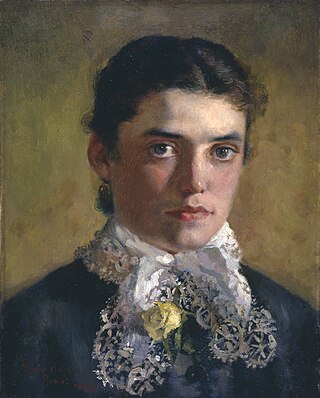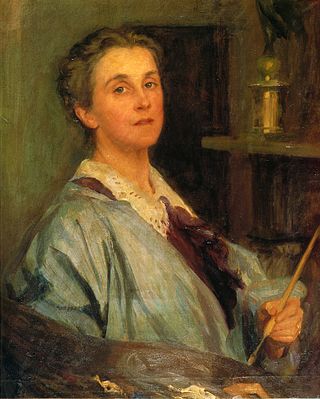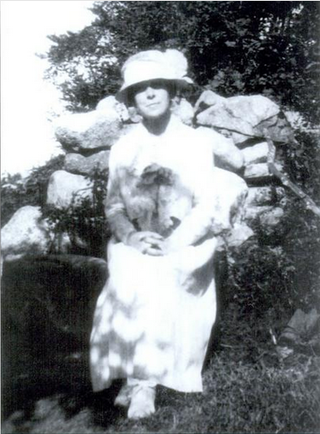Related Research Articles

Lilla Cabot Perry was an American artist who worked in the American Impressionist style, rendering portraits and landscapes in the free form manner of her mentor, Claude Monet. Perry was an early advocate of the French Impressionist style and contributed to its reception in the United States. Perry's early work was shaped by her exposure to the Boston School of artists and her travels in Europe and Japan. She was also greatly influenced by Ralph Waldo Emerson's philosophies and her friendship with Camille Pissarro. Although it was not until the age of thirty-six that Perry received formal training, her work with artists of the Impressionist, Realist, Symbolist, and German Social Realist movements greatly affected the style of her oeuvre.
Florence Ann Griswold was a resident of Old Lyme, Connecticut, United States who became the nucleus of the "Old Lyme Art Colony" in the early 20th century. Her home has since been made into the Florence Griswold Museum, a National Historic Landmark.

Joseph Rodefer DeCamp was an American painter and educator.

Rhoda Holmes Nicholls was an English-American watercolor and oil painter, born in Coventry, England. She studied art in England and Italy, and her work was viewed and praised at the time by the queens of both countries. A body of work was created in South Africa by Nicholls of Port Elizabeth area's scenery, wildlife and architecture. She lived there on her brothers' 25,000-acre ostrich farm for one year.

Margaret Fitzhugh Browne was an American painter of portraits, indoor genre scenes, and still lifes.

Anne Whitney was an American sculptor and poet. She made full-length and bust sculptures of prominent political and historical figures, and her works are in major museums in the United States. She received prestigious commissions for monuments. Two statues of Samuel Adams were made by Whitney and are located in Washington, D.C.'s National Statuary Hall Collection and in front of Faneuil Hall in Boston. She also created two monuments to Leif Erikson.

Lydia Field Emmet was an American artist best known for her work as a portraitist. She studied with, among others, prominent artists such as William Merritt Chase, Harry Siddons Mowbray, Kenyon Cox and Tony Robert-Fleury. Emmet exhibited widely during her career, and her paintings can now be found hanging in the White House, and many prestigious art galleries, including the Metropolitan Museum of Art.
Leila Daw is an American installation artist and art professor; her work uses diverse materials to explore themes of cartography and feminism.

The Boston School was a group of Boston-based painters active in the first three decades of the twentieth century. Often classified as American Impressionists, they had their own regional style, combining the painterliness of Impressionism with a more conservative approach to figure painting and a marked respect for the traditions of Western art history. Their preferred subject matter was genteel: portraits, picturesque landscapes, and young women posing in well-appointed interiors. Major influences included John Singer Sargent, Claude Monet, and Jan Vermeer. Key figures in the Boston School were Edmund C. Tarbell, Frank Weston Benson, and William McGregor Paxton, all of whom trained in Paris at the Académie Julian and later taught at the School of the Museum of Fine Arts. Their influence can still be seen in the work of some contemporary Boston-area artists.

Lucy May Stanton was an American painter. She made landscapes, still lifes, and portraits, but Stanton is best known for the portrait miniatures she painted. Her works are in the National Portrait Gallery in Washington, D.C., Metropolitan Museum of Art in New York, the Museum of Fine Arts in Boston, and the Philadelphia Museum of Art, where Self-Portrait in the Garden (1928) and Miss Jule (1926) are part of the museum's permanent collection.

Elizabeth Okie Paxton (1878–1972) was an American painter, married to another artist William McGregor Paxton (1869–1941). The Paxtons were part of the Boston School, a prominent group of artists known for works of beautiful interiors, landscapes, and portraits of their wealthy patrons. Her paintings were widely exhibited and sold well.

Helen Mary Knowlton was an American artist, art instructor and author. She taught in Boston from 1871 until the mid-1910s, when she was in her 70s. Her instructor and later employer, William Morris Hunt, was the subject of a portrait she made and several books; she is considered his principal biographer.

Marion Boyd Allen was an American painter, known for her portraits and landscapes.

Agnes Weinrich was an American visual artist. In the early twentieth century, she played a critical role in introducing cubist theory to American artists, collectors, and the general public and became one of the first American abstractionists. A life-long proponent of modernist art, she was an active participant in the art communities of Provincetown and New York. Early in her career, she traveled widely in Europe and spent extended periods studying in Paris and Berlin. She also studied art in Chicago, Provincetown, and New York. During most of her career, she worked in a Provincetown studio during the warm months and a Manhattan studio during the cold ones. Weinrich's easel work included oil paintings, watercolors, and pastels. She also made block prints and etchings and drew using pencil and crayon. Her paintings, prints, and drawings appeared in solo and group exhibitions throughout her career and she received favorable critical attention both during her life and after her death.
Elizabeth Campbell Fisher Clay (1871–1959) was an American artist and painter. Clay studied art in Boston, New York, and Paris. After her marriage, she lived in Halifax, West Yorkshire, England and exhibited in London, including two exhibitions at the Royal Academy of Arts.

Mary Brewster Hazelton was an American portrait painter. She attended the School of the Museum of Fine Arts, Boston, where she was later an instructor. Among her other achievements, Hazelton was the first woman to win an award open to both men and women in the United States when she won the Hallgarten Prize from the National Academy of Design in 1896. Her portrait paintings are in the collections of the Massachusetts State House, Harvard University, Peabody Essex Museum, and Wellesley Historical Society. The professional organizations that Hazelton was affiliated with included the Wellesley Society of Artists, of which she was a founding member, and The Guild of Boston Artists, of which she was a charter member. She lived her adult life with her sisters in the Hazelton family home in Wellesley, Massachusetts.
May Gearhart was an American printmaker who was part of an early 20th century circle of Southern California printmakers strongly influenced by the Arts and Crafts movement and Japanese art.

Mary Bradish Titcomb was an American painter, mainly of portraits and landscapes. She is often grouped with the American Impressionists.
Ellen Banks was an American painter and multi-media artist using only printed musical scores as inspiration for her paintings.

Ellen "Nelly" Thayer Fisher was an American botanical illustrator. Fisher exhibited her paintings at the National Academy of Design and other exhibitions. She was an active contributor to the exhibitions of the American Watercolor Society, beginning in 1872. In addition to being shown in galleries and exhibitions, her paintings of flora and fauna were widely reproduced as chromolithographs by Boston publisher Louis Prang.
References
- 1 2 Jules Heller; Nancy G. Heller (19 December 2013). North American Women Artists of the Twentieth Century: A Biographical Dictionary. Routledge. ISBN 978-1-135-63882-5.
- 1 2 "gertrudenason.com" . Retrieved 31 January 2017.